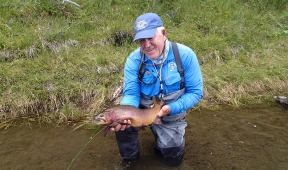
Last December I wrote a blog about the ongoing effort to restore cutthroat populations in Yellowstone Lake, the Yellowstone River and tributaries in Yellowstone National Park. Lake trout were first documented in Yellowstone Lake in 1994 and evidence from chemical patterns in the ear bones of lake trout captured in the late 1990s indicate that they were introduced illegally from a nearby lake sometime in the 1980s. Cutthroat trout comprise about 80% of a mature lake trout’s diet. Biologists estimate 41 cutthroat trout are saved each year for every mature lake trout caught.
It wasn’t long after lake trout were first documented that the cutthroat trout population started a downward trend. It was estimated that the heavy toll resulting from lake trout predation could result in less than 10% of the cutthroat trout population of the historic high.
In 2008, a scientific review panel set up to evaluate the lake trout suppression program overwhelmingly agreed that the Yellowstone Lake cutthroat trout population is in serious trouble, but that suppression efforts could restore this population to healthy levels. They believed very little time remained to turn the situation around, and recommended park managers increase lake trout removal.
Starting in 2009, the park contracted with Hickey Brothers Fisheries, LLC, a commercial fishing company, to increase the take of lake trout. Beginning in 2011, they also used large, live entrapment nets that allow removal of large lake trout from shallow water while returning cutthroat trout to the lake with little mortality.
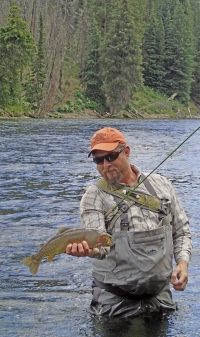
A movement study, to pinpoint lake trout spawning beds and identify movement patterns, was launched in 2011 by NPS and the US Geological Survey. Over 300 lake trout were equipped with telemetry tags and over 40 stationary receivers were deployed throughout the lake to monitor movements. Additionally, NPS and Montana State University began a mark/recapture study of lake trout in Yellowstone Lake in 2013. In order to estimate population size, 2,398 lake trout captured in trap nets were given 2 plastic “spaghetti” tags and released back to the lake. The ratio and distribution of recaptures of these fish aids researchers in estimating the total number of lake trout in the lake. Anglers catching any tagged fish should return the tags to their nearest Ranger Station or the Fisheries Office in Yellowstone National Park.
Hydroacoustic surveys (using sonar-based fish finders) are used to assess the lake trout’s seasonal movements within the lake. The surveys confirmed lake trout concentrations in the western portion of Yellowstone Lake. These surveys also revealed medium-sized (12–16 inches) lake trout tended to reside in deeper water (greater than 130 feet) than Yellowstone cutthroat trout. Now biologists can more easily target lake trout without harming cutthroat trout. Hydroacoustic data also provides minimum abundance estimates of both cutthroat and lake trout, which is invaluable information for long-term evaluation of control efforts.
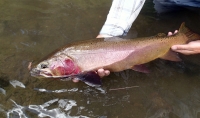
More than 1.7 million lake trout have been removed from Yellowstone Lake since the lake trout’s presence was confirmed in 1994. In 2014, National Park Service and contracted crews captured more than 277,000 lake trout. Because the amount of effort put into gillnetting as well as the lake trout’s abundance affects the number removed, the number caught per 100 meters of net in one night (catch per unit of effort, CPUE) is also monitored. This number has been rising since 2002, suggesting that the population has been increasing faster than the fish are being removed, until 2012. In 2012, increases in net effort led to a significant decrease in CPUE, the first drop seen since 2002. CPUE decreased even further downward in 2013 and 2014.
One goal of Yellowstone’s Native Fish Conservation Plan (2010) is to reduce the population by 25 percent each year until it collapses to an insignificant level. Population modeling suggests this may be possible with a continued increased effort.
With current technology, lake trout probably cannot be eliminated from Yellowstone Lake. However, ongoing management of the problem can significantly reduce lake trout population growth and maintain the cutthroat trout population, which is a critical ecological link between Yellowstone Lake and its surrounding landscape.
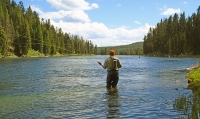
I had not fished the stretch of the Yellowstone River below the lake for almost 20 years until last October. While I didn’t land many fish, those that I hooked were very impressive. On July 15th, opening day, our assistant manager Todd Lanning and I decided to give the Yellowstone another shot.
The traffic was simply horrendous which was to be expected. We left our shop in Island Park at 8 am and arrived at our destination just upstream from the Sulphur Caldron exactly 2 hours later. By that time it seemed like there was an angler on every rock. I have never seen the Yellowstone River so busy. I found a spot above one of my favorite runs while Todd worked his way upstream. There were two anglers in my favored spot so I just hung out and waited my turn. Eventually they moved on so I waded in.
There were a few PMDs and caddisflies coming off but no fish rising. I clinched a Henry’s Fork Foam Golden Stone to my 4X tippet and dropped a Two Bit Hooker about 30 inches below the dry fly. I carefully worked my way along the gravel bar where it dropped into deep, green water. I didn’t see a sign of a trout. I’ve always had success in this water so I decided to rest the water and give it another shot.
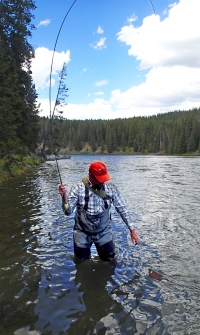
About halfway through the run I had a take on the nymph but didn’t connect. I waited a few minutes and made a second cast. The fish took again and this time the set was solid. The fish shot out into the current and bolted downstream. The fish was powerful and strong. Eventually I brought it to net, a fat, colorful female at least 20 inches long.
Later I spotted a long, dark shape in the riffle at the head of the run. It looked too long to be a trout but I decided to give it a cast. The fly hesitated, I set the hook and to my surprise a huge cutthroat bolted from the riffle into deeper water. After a long battle I had the trout in my grasp, a dark male far bigger than any cutthroat I had ever landed in the Yellowstone River. The trout was at least 23 inches long and wider than my fist across the back. I could see Todd working his way back downstream but he was too far away to get a photo so I slipped the fish back home.
When we got back together Todd reported landing a couple of big fish using a streamer. We decided to drive upstream to check out another spot. Buffalo Ford which is now called Nez Perce Ford was too crowded to find a parking spot. We eventually stopped above LeHardy Rapids and walked down to the river.
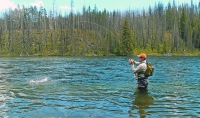
Again, the river was so crowded it didn’t look like we could find a place to fish. We worked our way downstream until we found a section of deeper water that wasn’t as busy. We sat on a comfortable grassy bank where we could sit and watch the water. By then golden stones started flying mixed with a few large salmonflies. Every now and again we saw a trout break the surface.
We spent the next 4 hours taking turns casting, missing fish, hooking fish, fighting fish, losing fish and landing fish. Most of the trout were 20 inches or more but there were also a few smaller trout in the 14 – 16 range, a good sign that the program is working.
We pulled out and headed for home about 5 pm. We both marveled at the condition, size and number of trout. It was truly a memorable day. We tip our hats off to the fisheries managers of Yellowstone Park. Restoring the cutthroat trout population in a lake that covers 136 square miles seems more than a daunting task. Yet the population has turned the corner and is on the upswing. I’ll be back later this week.